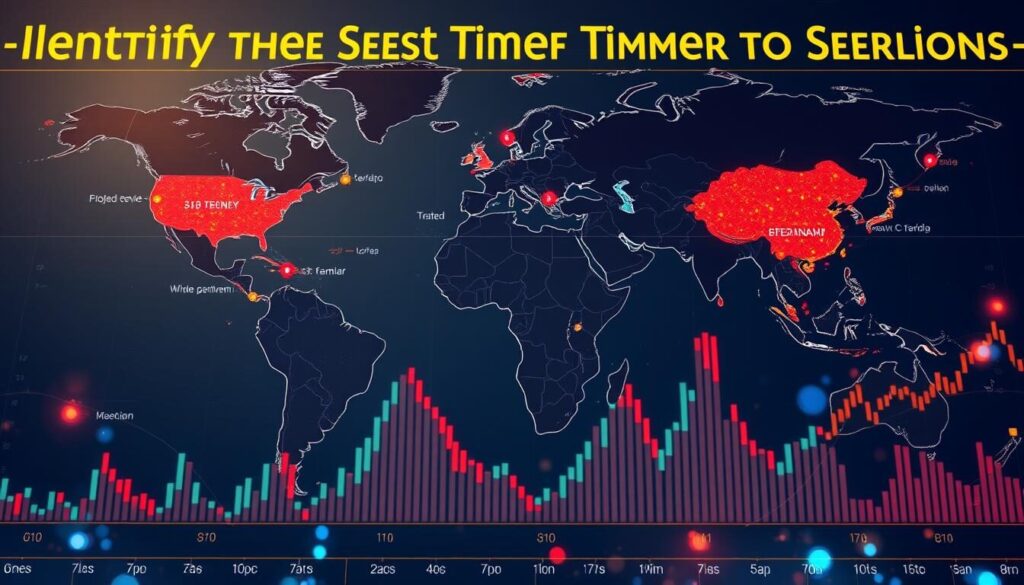While Wall Street sleeps, the world’s largest financial market never hits pause. Picture this: 58% of all currency trades happen between 8 AM and noon EST – the golden overlap when New York sips coffee while London finishes lunch. It’s like Times Square at midnight, but with dollars, yen, and euros changing hands.
We’ve all seen stock markets close at 4 PM sharp. But currencies? They’re the night owls of finance. Imagine a 24/5 relay race where Tokyo passes the baton to London, who hands it to New York, then Sydney – creating one seamless global heartbeat. No starting gun, no finish line.
Why does this matter to you? Timing isn’t just everything – it’s the only thing. Trade during sleepy hours, and you might as well yell into a void. Catch the right session overlap? That’s when markets hum like a Tesla battery. We’ll show you how to ride these waves without pulling all-nighters (unless you want to).
Key Takeaways
- The currency market operates 24 hours a day, five days weekly – no opening bells or closing gates
- Major trading hubs (New York, London, Tokyo, Sydney) create overlapping “hot zones” for activity
- U.S./London overlap (8 AM-12 PM EST) sees more action than Black Friday shopping sprees
- Understanding session rhythms helps avoid trading during “zombie hours” of low liquidity
- Think global time zones like a World Clock app – but with profit potential baked in
Understanding Forex Market Hours
The sun never sets on currency exchanges – it’s like a global relay race where Tokyo hands off to London, then New York picks up the baton. This 24/5 rhythm means someone’s always buying euros while others sleep. No opening bells, no closing gates – just one endless financial heartbeat.
An Overview of the 24-Hour Trading Cycle
Think of it as the world’s largest convenience store for money. Sydney kicks things off at 9 PM UTC (that’s 5 PM New York time). When Tokyo’s traders arrive at midnight UTC, the yen starts dancing. By 7 AM UTC, London takes over – that’s when 36% of all deals happen. New York jumps in at 1 PM UTC, creating the famous “power hours” where markets move like caffeinated cheetahs.
How Time Zones Shape the Action
Your location determines which currency pairs come alive. Australians trade AUD/JPY during their morning coffee, while Europeans push EUR/USD at lunch. The real magic happens during overlaps – like when London and New York both work from 1 PM to 4 PM UTC. That’s when you’ll find the best time to trade major pairs, with spreads tighter than yoga pants.
Pro tip: Market hours aren’t just clocks – they’re traffic patterns. Trade USD/CAD when Toronto wakes up, or catch the GBP/JPY wave as Tokyo winds down. It’s like surfing – catch the right wave, and you’ll ride it all the way to shore.
Decoding Global Trading Sessions

Imagine four global stages where currencies perform daily – each with its own rhythm and fanbase. These sessions aren’t time slots. They’re distinct acts in a 24-hour financial theater.
The Sydney Warm-Up Act
While New Yorkers finish Sunday dinners, Sydney’s traders fire up terminals at 5 PM EST. This opening act moves slower than a sloth on melatonin – perfect for testing strategies without market tantrums. Think of it as the calm before the Tokyo storm.
Tokyo’s Precision Dance
When USD/JPY pairs start grooving at 7 PM EST, it’s like watching a katana slice through price charts. Tokyo’s session delivers surgical moves:
| Currency Pair | Average Daily Pips | Peak Hours (EST) |
|---|---|---|
| USD/JPY | 92 | 8 PM – 2 AM |
| AUD/JPY | 64 | 9 PM – 1 AM |
| NZD/JPY | 47 | 10 PM – Midnight |
London Meets New York: The Main Event
At 8 AM EST, two financial titans collide. London’s tea drinkers and New York’s coffee addicts create a 4-hour frenzy where:
- EUR/USD spreads shrink tighter than skinny jeans
- 60% of daily GBP trades happen
- Market moves resemble a caffeinated squirrel
This overlap isn’t just the best time to trade – it’s where fortunes shift faster than TikTok trends. Miss it, and you’re watching the game highlights instead of playing.
Forex Brokers’ Trading Hours Explained

Not all currency shops keep the same neon sign hours. While markets technically run 24/5, brokers play by their own rules – like diners with secret menus. Some stay open until 4:30 PM EST on Fridays, others lock doors at 5 PM sharp. These small differences? They’re the hidden dials controlling your trading experience.
When Clocks Collide
Here’s the twist: brokers don’t sync watches. During daylight saving shifts, London might jump ahead while New York lags. One platform’s “peak hours” could be another’s coffee break. This creates pockets where:
- EUR/USD spreads balloon like birthday balloons
- Liquidity evaporates faster than morning dew
- Price swings resemble a toddler’s sugar rush
“Trading during broker handoff periods feels like shouting into a hurricane – your orders might get lost in the storm.”
Take Axi’s extended Friday hours. While competitors wind down, their traders catch last-minute moves. But here’s the catch – fewer players mean wilder price jumps. It’s like surfing after the lifeguards leave: thrilling, but riskier.
| Broker | Friday Close (EST) | DST Adjustment |
|---|---|---|
| Broker A | 4:30 PM | Automatic |
| Broker B | 5:00 PM | Manual |
| Broker C | 5:30 PM | None |
Smart traders stalk these schedule gaps. Overlap periods between brokers become volatility goldmines – where currencies bounce between platforms like pinballs. Pro tip: Bookmark your broker’s holiday calendar. Nothing kills momentum faster than showing up to an empty market party.
Identifying the Best Time to Trade

Currency markets have more personality than a rock concert crowd – some zones mosh pit wild, others lounge like jazz clubs. Your job? Find the stage where your strategy headbangs best. Let’s cut through the noise.
Prime Time Playbook
That magical 8 AM to noon EST window? It’s not just busy – it’s Wall Street meets London rush hour. Picture this:
| Currency Pair | Peak Activity | Average Spread |
|---|---|---|
| EUR/USD | 8:30-11 AM EST | 0.8 pips |
| GBP/USD | 9 AM-Noon EST | 1.2 pips |
| USD/CHF | 8-10:30 AM EST | 1.5 pips |
These times see spreads shrink faster than ice cubes in July. More volume means smoother entries and exits – like finding empty checkout lanes during holiday sales.
Newbies often try to trade all four sessions. Bad move. It’s like binge-watching Netflix without snacks – you’ll crash by episode three. Focus on one or two zones that match your sleep schedule and currency preferences.
“Treat markets like tidal patterns – ride the waves you understand, skip the riptides.”
Pro tip: Set alarms for overlap periods like you would for sunrise hikes. Miss the golden hour, and you’re photographing shadows. Catch it right, and you’ll capture moves worth framing.
The Role of Market Overlaps in Volatility

When financial hubs shake hands, markets catch fire. Overlaps occur when two major trading zones operate simultaneously – think London bankers sipping espresso while New York traders down their third coffee. These collisions create fireworks: 58% of all deals happen during the U.S./London overlap, making it the Wall Street equivalent of a Black Friday stampede.
Understanding U.S./London and Sydney/Tokyo Overlaps
The London New York mashup (8 AM – 12 PM EST) turns currencies into hyperactive puppies. Why? More players mean tighter spreads and faster moves. It’s like trying to order at a packed food truck – everyone’s shouting at once, creating chaos… and opportunity.
Compare that to the Sydney/Tokyo overlap (7 PM – 4 AM EST). This quieter period resembles a library study group – fewer participants, smoother price action. But don’t snooze: major news releases here can still trigger ninja-quick moves in Asian pairs.
| Overlap | Time (EST) | % of Daily Volume | Average Spread (EUR/USD) |
|---|---|---|---|
| U.S./London | 8 AM – 12 PM | 58% | 0.7 pips |
| Sydney/Tokyo | 7 PM – 4 AM | 12% | 2.1 pips |
Pro tip: Treat overlaps like weather forecasts. The New York session storm brings thunderous moves – perfect for surfers who love big waves. Tokyo’s drizzle? Better for fishing with patience. Either way, trading sessions demand respect:
- Economic reports during overlaps act like surprise party poppers – sudden bursts, then silence
- Liquidity evaporates faster than spilled coffee when sessions disconnect
- Spreads during quiet hours balloon like overinflated beach balls
“Trading overlaps is like dating two people at once – exciting, but someone’s getting hurt if you’re not careful.”
How Economic News Shapes Market Movements

Economic reports hit markets like surprise plot twists in your favorite Netflix series. One minute you’re coasting through a quiet Tokyo session – next thing you know, Japan’s GDP numbers drop, sending USD/JPY swinging faster than a pendulum. These moments separate casual observers from prepared traders.
Impact of Key Financial Releases
Think of CPI data as market espresso shots. When U.S. inflation numbers land during the London session, EUR/USD often moves 50 pips before your latte cools. Major releases create domino effects:
- Interest rate decisions act like earthquake alerts – everyone scrambles for position
- Unexpected GDP results turn quiet trading hours into mosh pits of activity
- Employment data during Sydney session can make AUD pairs hop like kangaroos
Remember July 2024? U.S. retail sales smashed expectations at 8:30 AM EST. The dollar surged 1.2% against the euro before London traders finished their biscuits. Timing is everything – news hitting during trading session overlaps amplifies the chaos.
Weathering the Storm
When volatility strikes, treat it like a sudden rain shower. Carry these umbrellas:
- Set stop-loss orders tighter than drum skins during high-impact events
- Focus on pairs you know better than your Netflix password
- Avoid trading Tokyo-London handoffs if you hate rollercoasters
“Track economic calendars like your dating app notifications – but only swipe right on events that matter to your strategy.”
Pro tip: Central bank speeches during quiet trading hours often create sneaky opportunities. Like finding a twenty in last winter’s coat – unexpected, but oh-so-sweet when it happens.
Practical Strategies for Optimal Trading Scheduling
Treat your trading day like a Netflix queue – binge too much, and you’ll crash before the finale. Smart scheduling isn’t about chasing every market opens bell worldwide. It’s picking your battles like a chess master eyeing the board.
Playbook for Profit Hunters
Start with the London New York overlap (8 AM-12 PM EST). This four-hour window moves more cash than a Brinks truck heist. Here’s how to attack it:
| Time Slot | Action Plan | Currency Pair Focus |
|---|---|---|
| 8-9 AM EST | Scan news feeds | EUR/USD, GBP/USD |
| 9-11 AM EST | Execute trades | USD/CAD, USD/JPY |
| 11 AM-Noon EST | Review positions | XAU/USD |
Set daily targets tighter than your jeans from high school. Example: “I’ll take 3 quality setups in the York session” beats “I’ll trade until my eyes bleed.”
The Art of Strategic Naps
Markets need breathers too. Schedule breaks like workout rest periods:
- 15-minute walk after 90 minutes of screen time
- Full lunch hour during Tokyo-Sydney handoff
- Friday afternoons off (unless NFP data drops)
Pro tip: Use quiet hours day periods for research. When Asia sleeps, analyze your currency pair charts like a detective reviewing case files. Need help timing these optimal trading windows? Set phone alerts for key market opens – it’s like having a personal trading concierge.
“Successful traders treat their minds like premium fuel – you wouldn’t put regular gas in a Ferrari.”
Managing Time Zones and Daylight Saving Adjustments
Time zones in currency markets are like puzzle pieces that never quite fit. One week London and New York hold hands at 8 AM EST – next month, daylight saving yanks them apart. This dance affects every trading strategy, especially when chasing pairs like EUR/USD across days week.
Your Time Zone Cheat Sheet
Here’s the kicker: markets don’t care if you confuse EST with UTC. Use these tools to stay sharp:
- World Time Buddy: Drag-and-drop cities like Tokyo and Sydney
- TradingView’s session markers: Color-coded bars on charts
- Smartphone widgets: Set 4 clocks (London, NY, Tokyo, Sydney)
“Time zones are your silent trading partner – ignore them, and they’ll empty your wallet.”
| Region | DST Start | Market Shift |
|---|---|---|
| U.S. | March 10 | NY opens 1 hour earlier |
| Europe | March 31 | London closes 1 hour later |
| Australia | October 6 | Sydney-Tokyo overlap shrinks |
When DST hits, the opening closing chaos begins. EUR/USD might surge at 2 PM GMT instead of 3 PM – enough to wreck stop-loss orders. Pro tip: Mark DST dates like birthdays. Your trading strategy depends on it.
Stick to pairs you know. If you trade forex using EUR/USD, track Frankfurt and New York hours like a hawk. Their 3-hour overlap? That’s your profit playground four days week.
Enhancing Liquidity Through Session Insights
Liquidity in markets works like a crowded subway station – more people mean easier exits and smoother rides. When New York traders join London’s afternoon crowd, currency pairs turn into liquid gold. Miss this window? You’re stuck trading in a ghost town.
Leveraging Overlap Opportunities
That magical 8 AM to noon EST overlap isn’t just busy – it’s the financial equivalent of a Super Bowl halftime show. Here’s why it matters:
- Spreads shrink faster than ice in July (think 0.7 pips on EUR/USD)
- Orders fill quicker than TikTok trends go viral
- Price action flows like a Netflix binge session
The New York session acts as liquidity’s MVP. When it teams up with London, you get:
| Overlap | Peak Activity | Liquidity Boost |
|---|---|---|
| NY/London | 8-11 AM EST | 58% daily volume |
| Tokyo/Sydney | 7 PM-2 AM EST | 18% daily volume |
Pro tip: Treat these windows like limited-time offers. The best platforms highlight real-time liquidity – use their tools to spot surges. Remember:
“Trade when others trade – solitude belongs to poets, not profit-seekers.”
Set alerts for time zones like you would for concert tickets. When New York’s lights come on, grab your seat. Miss it, and you’re watching the replay.
Conclusion
Currency markets don’t punch a time clock – they’re the ultimate shift workers of finance. Knowing when major hubs like London and New York shake hands isn’t just helpful. It’s your backstage pass to where the real action happens.
Here’s the golden ticket: session overlaps act like rush hour for your favorite currency pairs. Catch that sweet spot between time zones, and you’ll ride waves of tighter spreads and smoother trades. Miss it? You’re stuck window-shopping while others check out.
Three things to steal for your playbook:
- Sync your clock with the London/NY overlap – it’s where 58% of deals get done
- Track daylight saving shifts like your morning coffee ritual
- Let quieter hours fuel research, not FOMO trades
Think of it like planning a road trip. You wouldn’t leave without checking traffic patterns. Apply that same logic to your currency pairs, and suddenly those late-night Tokyo sessions or early Sydney starts make sense.
The market never sleeps – but with smart timing, you might finally get some rest. Set those session alerts, respect the clock, and watch your strategy hum like a well-oiled machine. Your future self will thank you when profits roll in like weekend brunch reservations.
